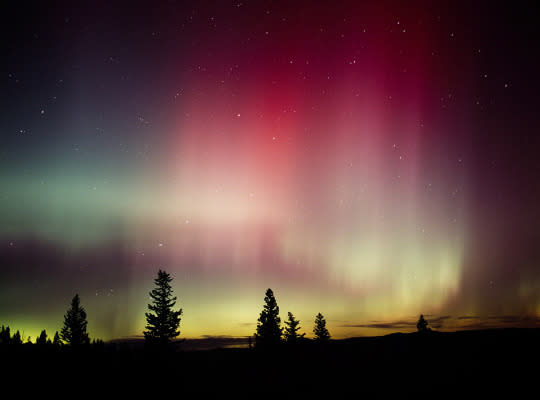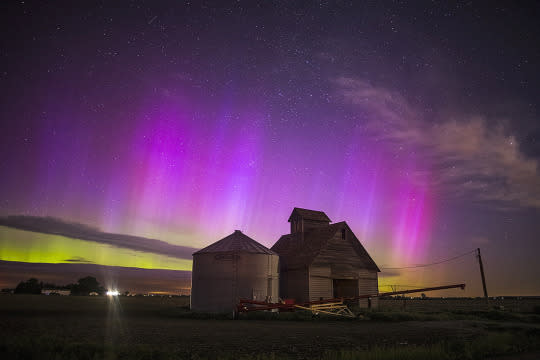Where to Spot the Northern Lights in the U.S. Before They Dim
Want to view the Aurora Borealis, the famed “Northern Lights?” This year you can skip the long voyage to northern Norway or Iceland, and just stay home in Iowa. When you think of the Aurora Borealis, it usually conjures visions of riding dog sleds to the outer reaches of the bitterly cold Arctic to view the spectacular shimmering greenish lights across the night sky.
But this year, because of a variety of factors, the Northern Lights have migrated south, like a giant glowing green goose, to hold its light show in spectacular fashion in Michigan as well as forecast to spread as far south as Missouri and Virginia. I recently caught a faint green night display off of Vancouver Island, in southern British Colombia. And last week, Pennsylvania and Iowa became prime viewing grounds.
Related: Last Chance to See the Northern Lights Before They Dim for a Decade

Moose Lake, Minnesota (Photo: Jim Brandenburg/Minden Pictures/Corbis)
So what is driving the lights so far south this year? And how long will they be around? For some insights and predictions, Yahoo Travel spoke with meteorologist Mike Bettes, host of “Weather Underground” on The Weather Channel.
“We’re seeing high pressure systems with low humidity and clear skies across the Midwest,” Bettes said, “and these weather patterns absolutely 100 percent affect the color and intensity of the Borealis.”
Related: Northern Lights and Craft Beer—Thursday Night in Fairbanks, Alaska

Northern Lights over Montana (Photo: Ctein/Science Faction/Corbis)
But the causes are not just of this Earth. “There’s been some recent increases in solar activity as well, with some flares creating radiation that reacts with the earth’s magnetic field.” It is this interaction between the sun’s radiation and our planet’s magnetic field that creates the Aurora Borealis, the short wavelengths manifesting themselves in the form of vivid green visible light. This year has been recognized as a “Solar Maximum” event, the high-point of an 11-year cycle of solar flare activity.
The U.S. government’s National Oceanic and Atmospheric Administration (NOAA) is tasked with monitoring solar activity and potential impact on terrestrial weather and life. For a cool animated Aurora Borealis forecast of where the lights can be seen, definitely check out the NOAA’s Space Weather Prediction Center website, updated daily. The site also has forecasts of the geomagnetic storms and solar flare activities that are prime drivers of the Northern Lights, as well as displays of graphic radiation-meters that are terrifying enough to make you want to put on a tin-foil hat.
Related: Watch: Northern Lights Upstage Milky Way

Lights over the Hoodoos in Wyoming (Photo: Fred Hirschmann/Science Faction/Corbis)
Aside from the solar flares and regular weather conditions, one further factor has been influencing the move of the Northern Lights. That’s right, the usual suspect of El Niño—the Pacific Ocean-based weather pattern that is forecasted to bring cooler, drier air to the U.S. north—and all the way to Alaska throughout winter.
“El Niño is definitely having an effect on the Borealis,” Bettes said. “It’s driving these cool, crisp fall nights we’ve been getting, and resulting in some spectacular displays.” Bettes cited Minnesota, Wisconsin, Michigan and Alaska as having some of the best light shows of the past couple weeks, with more that “should last through winter.”

Iowa (Photo: Mike Hollingshead/Corbis)
In case you’re wondering, the southern exposure of this year’s Borealis is far from being a record. Bettes said that in years past, faint lights have been spotted as far south as northern Georgia and South Carolina, with some claims of lingering orange glow appearing even in Cuba. As the distance from the magnetic North Pole becomes farther, the Earth’s atmosphere and the air’s humidity filters out the shorter wavelengths of light (like green) and only the longer wavelength lights (like orange) remain to be seen, so the southern locations usually don’t get the vivid hues seen in the Arctic, but this year is proving to be an exception.
So keep your eye on the solar flare charts, grab a thermos and a deck chair, and get ready to enjoy some free light shows across the entire northern quarter of the U.S. throughout this winter.
WATCH: Iceland: The Most Magical Layover Ever
Let Yahoo Travel inspire you every day. Hang out with us on Facebook,Twitter, Instagram, and Pinterest. Check out our original adventure travel series, “A Broad Abroad.”
